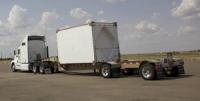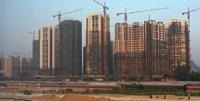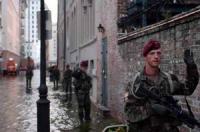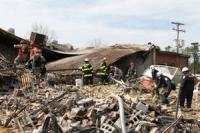-
Los Alamos nuclear waste successfully shipped to WIPP

The first shipment in five years of Transuranic (TRU) waste from the Los Alamos National Laboratory has been successfully delivered to the Waste Isolation Pilot Plant (WIPP) near Carlsbad, New Mexico.
-
-
Globally, rapid urbanization increases pressure on rural water supplies

Around the world, water reallocation from rural to urban regions—the practice of transferring water from rural areas to cities to meet demand from growing urban populations – is intensifying. Researchers found that 69 cities with a population of 383 million people receive approximately 16 billion cubic meters of reallocated water per year—almost the annual flow of the Colorado River.
-
-
Predicting, understanding urban flooding

Flooding is the natural hazard with the greatest economic and social impact on the population of the United States. Urban flooding is a complex and distinct kind of flooding, compounded by land use and high population density, and it requires a different approach to assess and manage.
-
-
Owners of unprotected coastal homes don’t rush to retrofit

Many coastal homes have significant structural vulnerabilities that leave homeowners and their homes largely unprotected from storms. Additionally, the majority of coastal homeowners have little to no intention of reducing these structural vulnerabilities, even though they live in areas frequently affected by damaging hurricanes and flooding.
-
-
Driving force of volcanic super-hazards uncovered
Volcanologists have discovered the driving force behind superheated gas-and-ash clouds from volcanic eruptions, which may help save lives and infrastructure around the globe. Endangering 500 million people worldwide, pyroclastic density currents (or pyroclastic flows) are the most common and lethal volcanic threat, causing 50 percent of fatalities caused by volcanic activity.
-
-
Predicting impacts of extreme events on grids
A new, free, open-source software reliably predicts how damage from hurricanes, ice storms, earthquakes, and other extreme events will restrict power delivery from utility grids. The Severe Contingency Solver for Electric Power Transmission is the only software available—commercially or open-source—that reliably supports analysis of extreme events that cause widespread damage.
-
-
A how-to guide for climate-proof cities
Traditionally, Maurepas Swamp serves as a natural barrier against flooding that threatens New Orleans each year. Native flora soaks up the rainfall, spreading it across a network of cypress roots and cattail. But centuries of logging and canal construction have drastically altered the swamp’s ecological composition. The Mississippi levee system compounded the issue, isolating the swamp from vital sources of fresh water and nutrients. Flooded with saltwater, much of the existing cypress withered and died. Young trees, now, are few and scattered.
-
-
Melting glaciers causing sea levels to rise at ever faster pace
Melting ice sheets in Greenland and the Antarctic as well as ice melt from glaciers all over the world are causing sea levels to rise. Glaciers alone lost more than 9,000 billion tons of ice since 1961, raising water levels by 27 millimeters.
-
-
Nagging security concerns over using Huawei’s tech in Europe
New report urges NATO members to look to emulate Britain, which created an entire government office to scrutinize Huawei’s products for security problems.
-
-
Bigger than Huawei: U.S. broadens scrutiny of Chinese technology
A flurry of seemingly disconnected actions by the U.S. government to curb the involvement of Chinese technology firms in the U.S. economy over the past year reflects the Trump administration’s intensifying concern that those firms could — now or in the future — abet espionage by Beijing’s intelligence services.
-
-
AI automatically detects disturbances in power supply grids
The grid is changing as the big, centralized providers of the past are replaced by smaller, distributed suppliers. Keeping such complex networks running stable requires high-resolution sensor technology – AI provides a way to make accurate predictions and automatically detect any disturbances or anomalies in real time.
-
-
Saving millions of lives by rapidly shifting to renewable energies
Reducing global air pollution can prevent millions of premature deaths according to an international team of scientists. The most significant contribution would be the rapid phasing out of fossil fuels, which is currently being discussed mainly to abate climate change.
-
-
Venezuela announces major energy rationing amid new power outages

Venezuelan President Nicolas Maduro has announced that the government will reduce the length of the country’s workday and keep schools closed as it attempts to ration electricity in the face of continued power cuts.
-
-
British oversight body: Security flaws in Huawei 5G networks
A British oversight board has slammed the Chinese telecom giant Huawei for software security flaws. The report, however, stopped short of blaming Chinese intelligence agencies for the engineering defects. The United States is concerned that Huawei is a front for the Chinese intelligence services, and that rolling out Huawei’s 5G system in Europe would open the door for Chinese spying or sabotage.
-
-
California hospitals to pay billions for seismic safety upgrades
California hospitals would need to make substantial investments—between $34 billion and $143 billion statewide—to meet 2030 state seismic safety standards, according to a new report.
-
More headlines
The long view
Water Wars: A Historic Agreement Between Mexico and US Is Ramping Up Border Tension
As climate change drives rising temperatures and changes in rainfall, Mexico and the US are in the middle of a conflict over water, putting an additional strain on their relationship. Partly due to constant droughts, Mexico has struggled to maintain its water deliveries for much of the last 25 years, deliveries to which it is obligated by a 1944 water-sharing agreement between the two countries.
Trump Is Fast-Tracking New Coal Mines — Even When They Don’t Make Economic Sense
In Appalachian Tennessee, mines shut down and couldn’t pay their debts. Now a new one is opening under the guise of an “energy emergency.”
Smaller Nuclear Reactors Spark Renewed Interest in a Once-Shunned Energy Source
In the past two years, half the states have taken action to promote nuclear power, from creating nuclear task forces to integrating nuclear into long-term energy plans.
Keeping the Lights on with Nuclear Waste: Radiochemistry Transforms Nuclear Waste into Strategic Materials
How UNLV radiochemistry is pioneering the future of energy in the Southwest by salvaging strategic materials from nuclear dumps –and making it safe.
Model Predicts Long-Term Effects of Nuclear Waste on Underground Disposal Systems
The simulations matched results from an underground lab experiment in Switzerland, suggesting modeling could be used to validate the safety of nuclear disposal sites.
